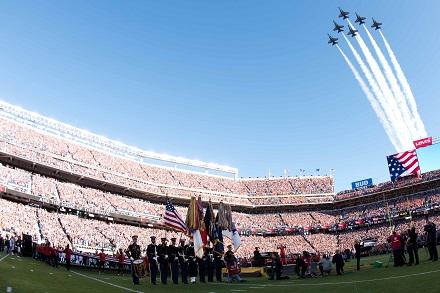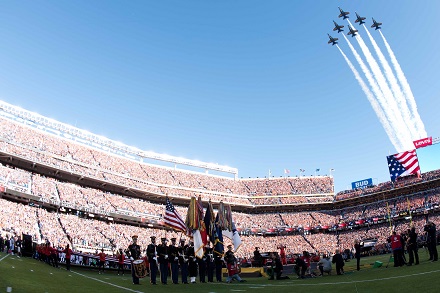

Specifically, YouTube and esports – where, it says, its target market hangs out.
According to an article in The Esports Observer, the Navy’s course correction shouldn’t surprise anyone: an online strategy is perhaps the best means to reach those between the ages of 17 and 28. Research conducted by the Navy and published in USNI News shows that group doesn’t watch TV as much – and can usually be found in the digital arena.
MediaPost notes that it’s a good move, since Gen Z, one of the target markets, is fast becoming one of the key spenders in the economy: “Today’s teens and young adults have been through financial bootcamp. They grew up under the economic uncertainty of the Great Recession, and then took on student debt in the hundreds of thousands of dollars to then enter a digitized gig force with little promise of stability. So it’s not surprising that Gen-Z-ers have become as financially literate as they are technologically savvy. “
Ultimately, that means goodbye to the Super Bowl, where, according to AdAge, a 30-second TV spot costs upwards of $5 million.
The only people whose feelings might be hurt are the NFL, which has been struggling to prove its value to a younger demographic. Skyhook notes that about 30 percent of Super Bowl attendees are ages 45-65 which is on par with the national average age of viewers who watch NFL. Only 13 percent were over 65 or between 20 and 30. And with Millennials and Gen Z-ers turning to online experiences – streaming games or watching the scores on social media – that figure isn’t likely to change.
As an aside, the NFL has some work to do, even in its current largest viewership. According to a survey by US Dish, in the 54+ age group, more people would rather watch election coverage than the Super Bowl. In fact, 60.17 percent of that demographic are planning on tuning into the elections, versus the 59.43 percent who are more excited about the Super Bowl.
But back to the promotional market, meaning the ad investment. The number of dollars the Super Bowl and other televised games will be missing from the military is nothing to sneeze at. Navy officials told USNI News that 2020 will see an expenditure of nearly $33 million – 97 percent of the advertising budget – invested in online advertising. A little more than $1 million will be spent on billboards ads and spots on local radio stations.
For those counting along at home, that leaves the Navy’s planned television buy at zero dollars.
It’s not like the Navy hasn’t tried television advertising; in fact, several years ago, it spent $20.2 million (about 45 percent of its $45-million advertising budget) in that space, as it launched its “Forged by the Sea” campaign during the 2017 Army/Navy football game.
But it wasn’t where the target audience really was, according to a statement made by Vice Chief of Naval Operations Adm. Robert Burke at the Military Reporters and Editors annual conference.
“One thing we did learn, is paying for a lot of TV ads in the middle of Super Bowl games,” Burke said. “[The] target audience is not watching that.”
The Navy started cutting back on TV advertising – and the move showed no negative effect on recruiting, according to Burke. In fact, advertising on the digital side (a strategy the Navy was already putting in place) allowed the Navy to meet its recruitment goals. In 2020, the Navy wants to add about 5,100 people to field a force of 340,500 active-duty personnel – and it believes it will find just about every one of those individuals in the digital space.
In February, expect to see the Navy unveil its new advertising campaign in esports, allowing contestants to compete against each other in various games online for cash prizes. The Navy will become a prominent sponsor of esports events and will also start fielding an all-Navy esports team pulled from the service’s current pool of active duty members.
USNI News notes, “The move follows an ongoing Navy effort on YouTube showing scenarios where Navy personnel compete against social media influencers, such as William Osman, a mechanical and electrical engineer with more than 1.4 million subscribers, in various skill tests. The idea is depicting what life is like in the Navy.”
But the confluence of the military and esports isn’t entirely new. Over the summer, Complexity Gaming announced a partnership with the U.S. Army, according to a press release circulated by Complexity. By working with the Army Installation Management Command’s Family and Morale, Welfare and Recreation (MWR) program, Complexity integrated esports into its Better Opportunities for Single Soldiers (BOSS) program.
The program kicked off at Fort Bliss in El Paso, Texas, on June 13, when Complexity gamers spent three days living and training like U.S. Army soldiers. During an intensive boot camp, players participated in military-style drills alongside active-duty service members. In addition to the physically demanding aspects, boot camp is a time for soldiers to learn discipline and resilience, and to work together as a team rather than as competitive individuals – something it was thought could benefit gamers.
Later in the same month, according to the Esports Observer, participants switched roles, and Complexity players and staff welcomed U.S. Army personnel to the team’s new GameStop Performance Center at The Star in Frisco, Texas, for their own esports boot camp. Soldiers used the facility’s Mind Gym, created in collaboration with Mamba Sports Academy and HyperX, as well as other features in the GameStop Performance Center.
The soldiers’ in-game training culminated in an esports tournament where the top 15 competed for various awards and bragging rights live on Army Entertainment’s Twitch channel. Fans were also able to learn more about the soldiers and how they discovered gaming through custom content posted on Complexity’s social channels.
The Esports Observer also noted, that according to a 2018 Syracuse University study, which the Navy used to create its online advertising strategy, esports viewership is expected to be around 84 million, which if true should surpass all other professional sports leagues except NFL viewers – and it’s showing gains there too. Something esports had over the NFL, though, was that 61 percent of esports viewers are under the age of 25.
And the Navy isn’t the only branch of the United States Armed Forces eyeing the esports pool as a potential fishing hole for recruits, according to The Esports Observer. “The U.S. Air Force signed a partnership with ELEAGUE in 2018, which included the collaboration and production of content and being on stage to deliver championship trophies to winning teams. The U.S Air Force was the MVP sponsor the ELEAGUE Counter-Strike: Global Offensive Major in Boston. The U.S Army already has its own esports team and actively competes in titles such as (what else?) Call of Duty.”

